#mekong delta agriculture
Explore tagged Tumblr posts
Text
Discovering the Agricultural Wonders of Mekong Delta
Mekong Delta, the fertile region of southwestern Vietnam, is known for its stunning natural beauty, rich culture, and diverse agriculture. The region is home to a thriving agricultural sector that produces rice, fruits, vegetables, and fish. In this article, we will take a closer look at the agricultural wonders of Mekong delta tours.

Farming Practices in Mekong Delta:
The farming practices in Mekong Delta are mainly traditional and organic, with the majority of the farmers still using water buffalo or hand plows to till their fields. The region's flat terrain is ideal for rice cultivation, and the rice fields stretch as far as the eye can see.
The farmers here use a unique irrigation system called the "muoi ba" system, which means "12-3" in Vietnamese. This system involves dividing the land into sections and rotating crops based on the time of year, ensuring that the soil remains fertile.
Mekong Delta's Crops:
Mekong Delta is famous for its abundance of crops, including rice, fruits, and vegetables. The region produces over half of Vietnam's total rice output, making it the country's rice bowl. The rice paddies are a sight to behold, especially during the harvesting season when the fields turn a golden hue.
The delta is also home to a diverse range of fruits, including coconuts, mangoes, pineapples, and dragon fruit. The tropical climate and fertile soil make it an ideal region for fruit cultivation. Additionally, the delta is known for its vegetable production, with farmers growing everything from lettuce to bitter melon.

Aquaculture in Mekong delta agriculture:
Mekong Delta is also renowned for its aquaculture, with a variety of fish and seafood being produced in the region. The delta's intricate system of waterways and canals is home to an abundance of fish, including catfish, tilapia, and snakehead fish.
The region's most popular seafood is shrimp, with the majority of the country's shrimp farms located in the delta. Additionally, Mekong Delta is famous for its production of the famous Vietnamese fish sauce, which is made by fermenting anchovies and salt.
Mekong Delta's agriculture is a vital part of Vietnam's economy and a major contributor to the country's food production. The region's farmers use traditional and organic methods to cultivate a diverse range of crops and produce high-quality seafood. Visitors to the region can witness the beauty of the rice paddies and enjoy the delicious fruits and seafood. A trip to Mekong Delta will provide a unique opportunity to discover the wonders of the region's agriculture and the hard work of its farmers.
1 note
·
View note
Text

Blooming water hyacinth in Hoi An, Quang Nam province.
Through Lush Aerial Photos, Pham Huy Trung Documents the Rich Textures and Colors of Vietnam’s Agriculture

Grass harvest, Mekong Delta

Grass harvest, Mekong Delta

Lotus harvest, Mekong Delta
#pham huy trung#photographer#aerial photography#culture#vietnam#southeast asia#agriculture#mekong delta
17 notes
·
View notes
Text

HÀNH TRÌNH 13 NĂM CỦA VINIMEX – NIỀM CẢM HỨNG TỪ TRUYỀN THỐNG NÔNG NGHIỆP NGÀN ĐỜI…
[English below]
"Ta không được chọn nơi mình sinh ra, nhưng ta được chọn cách mình sẽ sống" – Đây là triết lý mà bà Trần Vũ Quỳnh Như, Founder và CEO của Vinimex Group, luôn tâm đắc. Từ niềm cảm hứng sâu sắc về nền nông nghiệp Việt Nam hơn 4000 năm lịch sử, bà Như đã tạo nên hành trình 13 năm đầy tự hào cho VINIMEX. Được dẫn dắt bởi niềm đam mê và sự biết ơn đối với những sản vật mà mẹ thiên nhiên ban tặng, VINIMEX đã và ��ang góp phần đưa nông sản Việt vươn xa ra thế giới.
Trong suốt hành trình phát triển, VINIMEX không chỉ là một công ty xuất nhập khẩu nông sản mà còn là biểu tượng cho tình yêu và khát vọng lớn lao về một nền nông nghiệp bền vững. Từ những sản phẩm như khoai mì, gạo, hạt điều đến cà phê, trà và hạt tiêu, VINIMEX đã trở thành cầu nối vững chắc giữa nông sản Việt và thị trường quốc tế.
Việt Nam, với sự đa dạng về khí hậu và thổ nhưỡng từ Bắc chí Nam, đã tạo nên một nền nông nghiệp phong phú. Miền Bắc nổi bật với bốn mùa đậm sắc, đồng bằng châu thổ sông Hồng trù phú, mang lại nhiều sản vật quý giá. Miền Trung kiên cường, vượt qua khắc nghiệt của thời tiết, là vùng đất cằn nhưng sinh hoa trái, nơi các nông sản đặc biệt được trân quý. Miền Nam với ưu thế hệ thống sông ngòi và kênh rạch chằng chịt góp phần tạo nên vựa lúa chính của cả nước, có nguồn trái cây, thủy sản dồi dào.
Khởi đầu với một đội ngũ nhỏ hơn 10 người, đến nay VINIMEX đã phát triển mạnh mẽ với hơn 200 nhân sự tại các thị trường trọng điểm như Việt Nam, Campuchia, Myanmar và Philippines.
Hành trình 13 năm chỉ là khởi đầu – Bà Như và đội ngũ VINIMEX tiếp tục hướng tới tương lai, góp phần thúc đẩy nền nông nghiệp Việt Nam phát triển bền vững, không chỉ trong nước mà còn trên toàn thế giới.
—-
VINIMEX 13-YEAR JOURNEY – INSPIRATION FROM AN AGE-OLD AGRICULTURAL TRADITION…
"We cannot choose where we are born, but we can choose how we will live" – This is the philosophy that Ms. Tran Vu Quynh Nhu, Founder and CEO of Vinimex Group, holds dear. Inspired by Vietnam's rich agricultural history spanning over 4000 years, Ms. Nhu has proudly led VINIMEX through a remarkable 13-year journey. Driven by a passion for and gratitude toward the gifts of Mother Nature, VINIMEX has played an integral role in bringing Vietnamese agricultural products to the global market.
Throughout its development, VINIMEX has not only been an agricultural import-export company but also a symbol of love and aspiration for a sustainable agricultural future. From products like cassava, rice, and cashews to coffee, tea, and pepper, VINIMEX has become a strong bridge connecting Vietnamese produce with international markets.
Vietnam, with its diverse climate and soil stretching from North to South, boasts a rich agricultural heritage. The North is distinguished by its four vibrant seasons and the fertile Red River Delta, yielding many valuable products. The Central region, resilient in the face of harsh weather, is a land of arid soil that still bears fruit, where unique agricultural products are highly cherished. The South, with its vast Mekong Delta, is abundant with rice, fruit, and seafood, serving as the nation's food basket.
Starting with a small team of fewer than 10 people, VINIMEX has since grown to a strong force of over 200 employees in key markets such as Vietnam, Cambodia, Myanmar, and the Philippines.
The 13-year journey is just the beginning – Ms. Nhu and the VINIMEX team continue to look toward the future, contributing to the sustainable development of Vietnam's agriculture, not only domestically but also globally.
-----
CÔNG TY CP XUẤT NHẬP KHẨU VI NA ĐẠI VIỆT
Địa chỉ: Số 7-9, đường D5, khu phố Nhị Hoà, phường Hiệp Hòa, thành phố Biên Hòa, tỉnh Đồng Nai
Số điện thoại: (+84) 2513 918 534
2 notes
·
View notes
Text
Unveiling the Wonders of Vietnam's Mekong River: Nature, Culture, and Adventure
The Mekong River, one of the longest rivers in the world, flows through six countries in Southeast Asia, including Vietnam. The river is a vital part of the country's economy, culture, and ecology. The Mekong River in Vietnam is home to a diverse array of flora and fauna and plays a critical role in providing water for irrigation, transportation, and fishing.
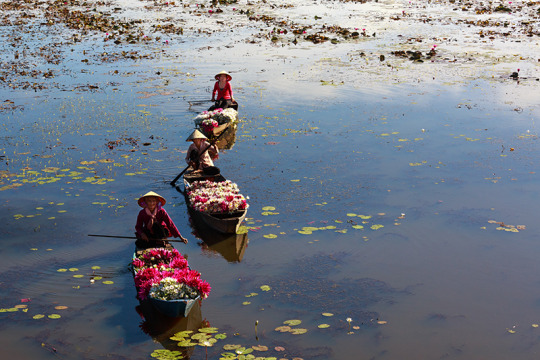
The Mekong River originates in the Tibetan plateau and flows through China, Myanmar, Laos, Thailand, Cambodia, and Vietnam before emptying into the South China Sea. In Vietnam, the Mekong River flows through several provinces, including An Giang, Dong Thap, Can Tho, and Vinh Long. The river plays a significant role in the region's agriculture, providing water for rice cultivation, fruit orchards, and fish farms.
One of the highlights of the Mekong River in Vietnam is the famous floating markets, which are unique to the region. These markets are a hub of activity, with vendors selling fresh produce and handicrafts from their boats. The most famous floating market is the Cai Rang Market in Can Tho, which attracts visitors from all over the world. The market is open every day, with the busiest time being early in the morning.
Another unique feature of the Mekong River in Vietnam is the many traditional villages that line its banks. These villages offer visitors the chance to experience the local culture and learn about traditional crafts such as mat weaving, rice noodle making, and coconut candy production. Visitors can also see the unique architecture of the region, including stilt houses that are designed to protect against flooding.
The Mekong River in Vietnam is also home to several ecotourism sites, which offer visitors the chance to explore the natural beauty of the region. One such site is the Tram Chim National Park, a protected area that is home to a diverse array of bird species, including the endangered Sarus Crane. Visitors can take a boat ride through the park, spotting birds and other wildlife along the way. Another popular ecotourism site is the Tra Su Cajuput Forest, a vast mangrove forest that is home to several rare and endangered species.
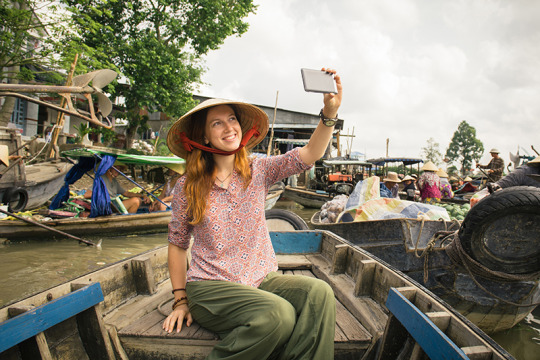
The Mekong River in Vietnam also plays a critical role in the country's transportation system. The river is a major thoroughfare, with boats and barges transporting goods and people up and down the river. Visitors can take a boat tour along the Mekong River, exploring the region's waterways and stopping at various villages and ecotourism sites along the way.
Food is an essential part of the Mekong River in Vietnam's culture, and visitors can sample some of the region's most famous dishes on their tour. One of the must-try dishes is the fish hotpot, a hearty stew made with fresh fish, vegetables, and spices. Another local specialty is the banh xeo, a crispy pancake that is filled with bean sprouts, pork, and shrimp.
In conclusion, the Mekong delta tours in Vietnam is a remarkable region that offers visitors a unique blend of culture, history, and natural beauty. Whether you're interested in exploring traditional villages, browsing floating markets, or immersing yourself in the region's ecotourism sites, a trip to the Mekong River in Vietnam is sure to be an unforgettable experience. So why not book your tour today and discover the wonders of this remarkable river?
2 notes
·
View notes
Text
CRISIS UPDATE 1.2: FISCAL POLICY?
September 11th, 2043
During the latest ASEAN conference on the global economy, the Minister of Finance, Yazan Abdullah Saaid, announced a new fiscal policy for the SEAF states. In their new fiscal policy, they have announced more tax breaks and the lowering of taxes towards individuals and corporations in ASEAN. With a large subsidy towards electronics, and tobacco, and an extremely large subsidy towards the food and aerospace industry. This aligns with the more neoliberal side of the government, with the PAP coalition supporting this fiscal policy.
More details of the fiscal policy are in the Minister of Finance’s speech, where he states: Implementation of Tax adjustments
Decreasing of income tax from 10% to 5%,
Decreasing of corporate income tax from 22% to 18%,
Increasing the Value Added Tax on luxury goods, nicotine-based products, and alcohol to 20% (Export goods being exempt from this tax),
Subsidies
Allocation of $10 Billion of the annual budget into subsidizing space resource extraction by SEAF entities,
Allocation of $300 Million of the annual budget into subsidizing electronics production by SEAF entities,
Allocation $200 Million of the annual budget into subsidizing the export of tobacco products,
Allocation $7 Billion of the annual budget into agriculture in order to reduce the import of food commodities,Strengthen Currency Reserves
All budget surplus will be exchanged into foreign currencies such as (but not limited to), U.S. Dollar, Euro, Chinese Yuan, etc. to increase the foreign exchange reserve of SEAF.
Implementation of Trade Tariffs
All goods passing through the Singaporean Space Elevator are subject to a 40% tariff (SEAF entities being exempt from this tariff),

These measures shall be enacted on 1 August, 2043.
This has been quite momentous to the SEAF as foreign businesses have sprung into action as they have set up more branches and investments in the SEAF countries, with the Mekong River delta becoming a hotbed for the electronics industry, with investments going up by 25%. Yet this has devalued the currency and stifled domestic industry.
However, this has come at the cost of the public approval of the neoliberal PAP coalition, as the government has come under protest due to the devaluation of the currency as the lower and lower middle classes suffer even more.
Will SEAF reverse their decisions? Or will they focus head on towards these neoliberal policies?
0 notes
Text
Top Countries that Import Rice from Vietnam

Keyword: Rice Importers, Rice Exporters,
With the passing years, Vietnam has also emerged as an unparallel entity in exporting rice products. This country has produced the world's many varied kinds of rice. New cultivation cultures along with proper climate conditions in appropriate places make it an inviting state with such suppliers that any nation around the globe likes to become its consumer. While reading this report, we shall try to look at those suppliers by whom this country imports the most significant share of the quantity for its rice importers and importers today, and also how demands towards rice produced in this state catch every other country eye if that nation is thirsty of producing or consuming similar qualities.
Vietnam is a giant when it comes to rice exports, and according to the reports, the export of rice in Vietnam is said to be 8.8 million metric tonnes in 2023, which is 36% more than the previous year, and it clearly comes with many opportunities for global rice importers. So come and explore this rice export market in Vietnam, and what are the top countries that play a significant role in exporting rice from Vietnam.
Highest Importing Countries of Rice from Vietnam
There are areas in Vietnam that are focused on growing rice; the top two and globally known are the Mekong Delta and the Red River Delta. The Mekong Delta becomes a very vital element for Vietnam as it produces more than 52% of Vietnam’s rice, and the 18% is mainly produced in the Red River Delta. Top countries that came into significant roles and came out as top rice importers in Vietnam are outlined here:
China
China is Vietnam's largest rice importing country. With over 30% in the total exports from Vietnam, China imports high volumes of rice mainly for massive population and rising middle-class demand.
Philippines
In Vietnam, the Philippines follows as the second-highest rice importing country due to this country's rapidly growing population and increasing demands for a cheap, good-quality product.
Indonesia
The largest economy in the Southeast Asia is importing huge shipments of Vietnam-grown rice, given its local requirement
Bangladesh
Being with huge population and scarcity of the arable land has full reliance on Vietnam-rice only for ensuring their food security
Malaysia
Malaysian government imports from Vietnamese sources to increase options wherein stability of supply shall also be ensured.
Africa (Ivory Coast, Ghana, Cameroon)
African nations buy more and more rice from Vietnam as they experience an increasing urge and relatively low prices due to a rise in the demand.
The demand for rice by Vietnam increases significantly on the following grounds:
Quality
The Vietnamese is preferred mainly because of their good quality rice. Such qualities have made the perfume-tasting Jasmine rice among other kinds highly appreciated.
Competitive Pricing
Vietnam rice is relatively cheaply priced; therefore, they are much more attractive for importing cheap yet quality rice.
Geographical Proximity
The closeness of Vietnam to its neighbouring countries in Southeast Asia enhances the process of trade among countries.
Trade Agreements
Vietnam signed trade agreements that lowered tariff barriers and enhanced trade relations.
Conclusion
Rice exports trade is Vietnam's growing milestone, mainly due to good quality, innovation, and sustainability. The top countries that export rice from Vietnam mentioned above will bring great opportunities for the global import and export of agricultural commodities. With increased growth in global rice demand, Vietnam has the opportunity of being the world leader where it offers high-quality rice to the importing countries coupled with a drive to bring about economic growth, employment, as well as poverty reduction to the homeland.
This should be a bright future for Vietnam's rice industry, it is full of scope for growth, diversification, and premium pricing. With the challenges and opportunities for innovation, Vietnam shall keep its position as a preferred supplier to the global market, ensuring food security and prosperity for generations to come.
Sources:
https://www.tradeimex.in/blogs/vietnam-rice-exports-2023-24 https://vietnamcredit.com.vn/news/list-of-top-rice-exporters-in-vietnam_14951 The organizations include:
Vietnam Customs's General Department
International Rice Research Institute
Food and Agriculture Organization of the United Nations
0 notes
Text
🌟 Khải Hoàn Impresses at OCOP Forum 2024: Bringing 5-Star Products to Consumers' Hands 🌟
🐟 With a strong commitment to delivering the true value of Vietnamese agricultural products, Khải Hoàn has continuously improved quality, meeting the most stringent requirements to bring 5-star OCOP products to consumers. The products showcased at the forum are the result of creative efforts, the application of advanced technology, and the preservation of traditional values.
🤝 Khải Hoàn's participation in the forum is not only an opportunity for exchange and cooperation but also a significant step in promoting the value of Vietnamese products, spreading the message of environmental protection, sustainable development, and contributing to improving the livelihoods of people in the Mekong Delta region.
🧚 The OCOP Product Connection Forum of the Mekong Delta Region 2024 runs until October 3, 2024, in Kiên Giang province. Everyone is invited to visit Khải Hoàn’s booth to experience the 5-star quality products and bring home gifts for your loved ones! #OCOP2024 #KhaiHoanPhuQuoc




0 notes
Text
Millions of people across Southeast Asia struggled Thursday with flooded homes, power cuts and wrecked infrastructure after Typhoon Yagi swept through the region, as the death toll passed 250.
In worst-hit Vietnam, the fatalities rose to 226, with nine confirmed dead in northern Thailand — where one district is suffering its worst floods in 80 years.
Myanmar’s national fire service confirmed the country’s first Yagi-related deaths after 17 bodies were recovered from flooded villages in the Mandalay region, while more than 50,000 people have been forced from their homes.
Yagi brought a colossal deluge of rain that has inundated a swathe of northern Vietnam, Laos, Thailand and Myanmar, triggering deadly landslides and widespread river flooding.
One farmer on the edge of Hanoi told AFP his entire 1,800 square metre peach blossom plantation was submerged, destroying all 400 of his trees.
“It will be so hard for me to recover from this loss — I think I will lose up to $40,000 this season,” said the farmer, who gave his name only as Tu.
“I really don’t know what to do now, I’m just waiting for the water to recede.”
The United Nations children’s agency (UNICEF) said the typhoon had damaged more than 140,000 homes across 26 provinces in Vietnam.
Floodwaters in Vietnam are receding, draining through the Red River — the main watercourse in the area — into the sea.
Authorities in several districts in the Red River delta ordered more than 50,000 people to evacuate their homes as a precaution while the runoff passes through.
– Communications cut off –
The floods have devastated more than 250,000 hectares of crops and huge numbers of livestock, Vietnam’s agriculture ministry said, with farmland around Hanoi hit hard.
In the deadliest single incident, a landslide in Lao Cai province annihilated an entire village of 37 houses, killing at least 42 people with 53 still unaccounted for.
Rescue teams pulled victims from the mud on Thursday, carrying them on stretchers to makeshift shelters where neighbours and relatives carefully washed the bodies in readiness for burial.
Survivors picked through the mud and wreckage to retrieve what family heirlooms and possessions they could find.
Fifteen bodies have been recovered in Cao Bang province after a landslide on Monday pushed a bus, along with several cars and motorbikes, into a stream, state media said Thursday.
– Myanmar camps –
Myanmar’s junta government has set up around 50 camps to help people affected by the floods, Lay Shwe Zin Oo, director of the social welfare, relief and resettlement ministry told AFP.
The Global New Light of Myanmar, the state-run newspaper, said train services on the main line between Yangon and Mandalay were suspended because some sections were flooded.
The Mekong River Commission, the international body overseeing the crucial waterway, issued a flood warning on Thursday for the historic Laotian city of Luang Prabang.
The Mekong is expected to hit flood levels in the coming days in Luang Prabang, a UNESCO world heritage site, the commission said in a bulletin.
In Thailand the death toll has risen to nine, the Department of Disaster Prevention and Mitigation said, including six killed in landslides in Chiang Mai province.
All flights were suspended in and out of the airport in Chiang Rai, some 145 kilometres (90 miles) northeast of Chiang Mai, aviation authorities said.
Further north, Mae Sai district on the border with Myanmar is suffering its worst floods in 80 years, Suttipong Juljarern, a senior interior ministry official said in a statement.
The Jet Ski Association of Thailand has sent 16 jet skis to help with relief efforts, Dechnarong Suticharnbancha, the body’s president told AFP.
Some of the currents in the floodwaters are too strong for normal boats but jet skis are able to navigate them because of their powerful engines.
A video showing champion jet skier Kasidit Teeraprateep rescuing an old woman from a torrent of murky water circulated on Thai social media.
Heavy monsoon rains lash Southeast Asia every year, but human-made climate change is causing more intense weather patterns that can make destructive floods more likely.
Climate change is causing typhoons to form closer to the coast, intensify faster and stay longer over land, according to a study published in July.
1 note
·
View note
Text
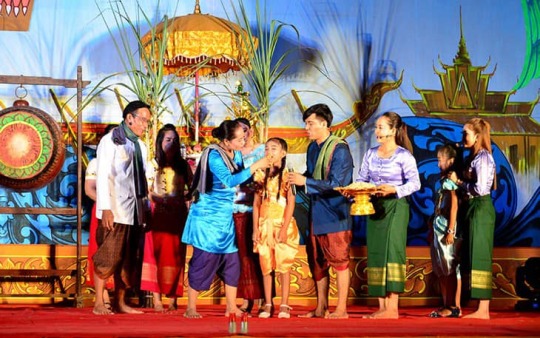
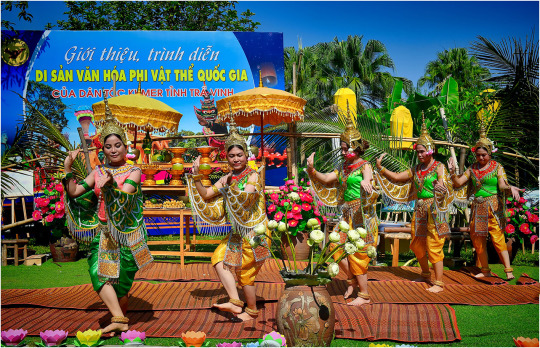
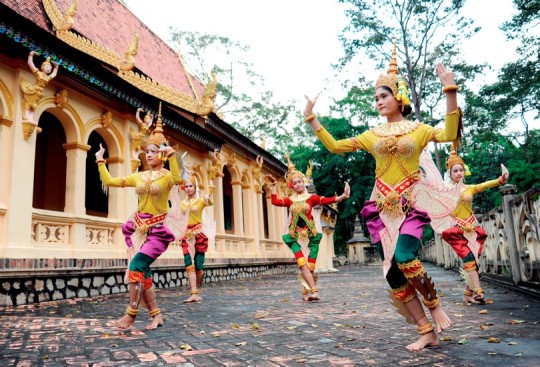

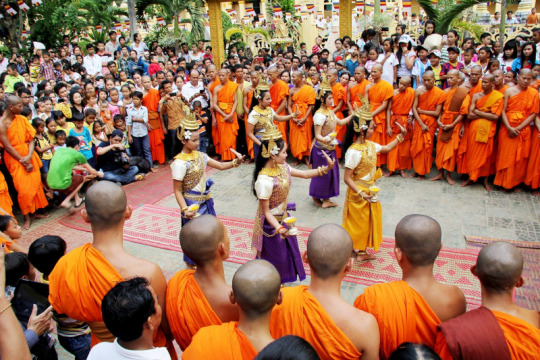

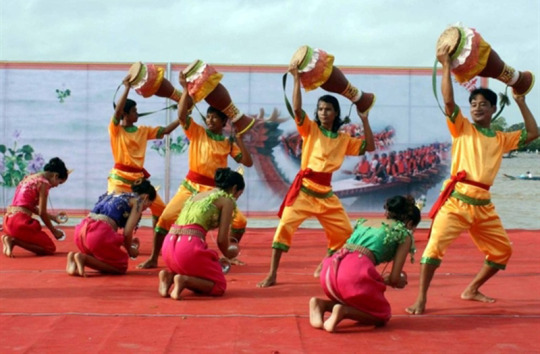
Culture and Customs of the Khmer Ethnic Group:
Ethnic minorities often reside in remote areas or high mountains, sustaining themselves through hunting or slash-and-burn agriculture. Introducing tourism to these communities can boost their income, mitigate environmental damage, and provide a refreshing climate for visitors. Let's join hands to protect our environment and make our Earth greener, cleaner, and more beautiful.
Traditional Social Institutions: The Khmer people in the Mekong Delta live in clusters known as "phum" (a small area comprising 3-8 related families) and "soc" (a traditional self-governing social unit similar to a Vietnamese village). Blood relations and marriage are the two basic relationships in the phum, while neighborly and territorial relations are blended with kinship in the soc.
Religion and Beliefs: Most Khmer in Vietnam are followers of Theravada Buddhism, which plays a crucial role in their spiritual life. Buddhist teachings and precepts have become standards in the relationships among the Khmer in the soc. Additionally, the Khmer have folk beliefs and festivals that contain many Hindu elements but are integrated into Buddhism.
Housing: Previously, the Khmer lived in stilt houses or earthen houses. However, nowadays, they almost no longer live in stilt houses. Over the past few decades, they have transitioned to living in earthen houses.
Attire: In the past, both Khmer men and women wore silk sarongs woven by themselves. Nowadays, young people prefer wearing trousers and shirts, while middle-aged and elderly people often wear black "ba ba" clothes. Affluent men sometimes wear white ba ba clothes with a scarf wrapped around their head or slung over their shoulder. Traditional clothes are worn only during weddings.
Cuisine: The staple food of the Khmer in the Mekong Delta is sticky rice. The special dish "tứksamlo" (rice noodle soup) is a favorite and indispensable on the first day of the Lunar New Year in the pagoda.
Education: Since the liberation (in 1975), especially in recent years, the development of education for the Khmer ethnic group has received special attention from the state and local authorities. According to the April 1, 2019, survey of 53 ethnic minorities: 76.7% of Khmer people aged 15 and above are literate in common script; the primary school attendance rate is 100.5%; the lower secondary school attendance rate is 72.3%; the upper secondary school attendance rate is 35%; and the rate of out-of-school children is 23.4%.
Festivals: The cultural and spiritual life of the Khmer is very rich. In their festival system, many unique festivals stand out, especially the two major ones in the year: Chol Chnam Thmay, the New Year festival, and Ok-ang Bok, the Moon Worship Festival, featuring the Ngo boat race among the phum - soc.
0 notes
Text
Discover the Magic of Vietnam: Top Places You Must Visit

Planning a Trip? Get All Your Travel Queries Answered at www.sarvodayaholiday.com
Vietnam, a country rich in history, culture, and natural beauty, offers travelers a diverse range of experiences. From bustling cities to serene landscapes, here are some of the top places you should not miss when visiting this enchanting Southeast Asian destination.
1. Hanoi - The Heart of Vietnam
Hanoi, the capital city, is a perfect blend of the old and new. Wander through the narrow streets of the Old Quarter, visit the historic Hoan Kiem Lake, and explore the Ho Chi Minh Mausoleum. Don’t forget to savor the local cuisine, especially the famous pho and bun cha.
2. Halong Bay - A Natural Wonder
Halong Bay is known for its emerald waters and thousands of limestone islands topped with rainforests. A boat cruise is the best way to explore this UNESCO World Heritage Site. You can also go kayaking or visit the fascinating caves like Sung Sot (Surprise Cave).
3. Sapa - The Land of Terraced Rice Fields
Located in the northern part of Vietnam, Sapa is famous for its stunning terraced rice fields and the rich culture of ethnic minorities. Trekking through the lush valleys and visiting local villages offers an unforgettable experience. The views from Fansipan, the highest peak in Indochina, are breathtaking.
4. Hoi An - The Ancient Town
Hoi An is a charming ancient town that is a UNESCO World Heritage Site. It’s known for its well-preserved architecture, lantern-lit streets, and vibrant markets. Take a leisurely bike ride around town, visit the Japanese Covered Bridge, and enjoy a cooking class to learn about Vietnamese cuisine.
5. Hue - The Imperial City
Hue is the former imperial capital of Vietnam, renowned for its historic monuments and pagodas. Explore the Imperial City, a vast complex of palaces, temples, walls, and gates. A boat ride on the Perfume River offers picturesque views of the Thien Mu Pagoda and other historic sites.
6. Da Nang - The Coastal Gem
Da Nang is a modern city with beautiful beaches, including My Khe Beach and Non Nuoc Beach. Don’t miss a visit to the Marble Mountains and the Golden Bridge at Ba Na Hills, a stunning piece of architecture that looks like it’s being held up by giant stone hands.
7. Ho Chi Minh City - The Bustling Metropolis
Ho Chi Minh City, also known as Saigon, is the largest city in Vietnam. It’s a vibrant metropolis with a mix of French colonial buildings and modern skyscrapers. Visit the War Remnants Museum, the Notre-Dame Cathedral Basilica, and the bustling Ben Thanh Market. The city’s nightlife is also lively and diverse.
8. Mekong Delta - The Rice Bowl of Vietnam
The Mekong Delta is a region of immense agricultural importance, known for its lush scenery and extensive waterways. Take a boat tour to explore the floating markets, fruit orchards, and traditional villages. The region’s tranquility offers a peaceful retreat from the city hustle.
9. Phu Quoc - The Tropical Paradise
Phu Quoc is an idyllic island known for its white sandy beaches, crystal-clear waters, and vibrant marine life. It’s a perfect destination for beach lovers, offering activities like snorkeling, diving, and sunbathing. Don’t miss the Phu Quoc National Park and the Vinpearl Safari.
Vietnam is a country that promises unforgettable experiences. Whether you're exploring ancient towns, bustling cities, or serene landscapes, each destination offers its own unique charm. Pack your bags and get ready to discover the magic of Vietnam!
#adventure#tourism#travel#traveling#travel agency#travel agency in india#travel destinations#trip#wanderlust#tourist#travel guide#travelling#destinations#explore#vietnam travel
0 notes
Text
A Journey Through Vietnam's Rice Basket to Where to Travel to in Vietnam
Embark on a captivating journey through Vietnam's rice basket, the Mekong Delta. This lush region in southern Vietnam offers a mosaic of rice paddies, verdant orchards, and winding waterways. Explore floating markets, ancient pagodas, and traditional villages, immersing yourself in local culture and cuisine. With its serene landscapes and authentic experiences, the Mekong Delta is a must-visit destination for travellers seeking a glimpse into Vietnam's rural charm and agricultural heritage.
Exploring The Mekong Delta of Where to Travel to in Vietnam
Discover the vibrant heart of the Mekong Delta, where to Travel to in Vietnam lush green rice paddies stretch as far as the eye can see. Explore floating markets in Can Tho and traditional villages along the delta's intricate network of waterways. This region offers a glimpse into rural Vietnamese life and is a photographer's paradise.
Serenity in Sapa of Where to Travel to in Vietnam
Nestled in the northern mountains, Sapa boasts breathtaking rice terraces carved into the hillsides. Hike through picturesque landscapes, encounter ethnic minority communities, and witness traditional farming practices. Sapa is a haven for nature enthusiasts seeking tranquillity and cultural immersion.
Historic Charm of Hoi An To Where to Travel to in Vietnam
Step back in time in Hoi An, a UNESCO World Heritage site renowned for its well-preserved ancient town. Explore narrow cobblestone streets lined with historic merchant houses, visit centuries-old temples, and indulge in delectable Vietnamese cuisine. Hoi An's lantern-lit evenings and artisan workshops create a magical atmosphere.
Majestic Ha Long Bay of where to Travel to in Vietnam
Embark on a cruise through HaLong Bay's emerald waters, surrounded by towering limestone karsts and mystical caves. This UNESCO-listed site offers unparalleled natural beauty, perfect for kayaking, swimming, and exploring hidden grottoes. Ha Long Bay is a must-visit destination for its iconic landscapes and serene seascapes.
Bustling Energy of Ho Chi Minh City of Where to Travel to in Vietnam
Experience the dynamic energy of Ho Chi Minh City, Vietnam's largest metropolis. Dive into its bustling markets, admire French colonial architecture, and delve into the city's tumultuous history at the War Remnants Museum. Ho Chi Minh City is a vibrant blend of tradition and modernity, offering endless opportunities for exploration.
Cultural Heritage in Hue of Where to Travel to in Vietnam
Explore the imperial city of Hue, once the seat of Vietnam's emperors and a UNESCO World Heritage site. Discover its majestic citadel, serene pagodas, and royal tombs nestled along the Perfume River. Hue's rich history and architectural splendour make it a captivating destination for history buffs and culture enthusiasts.
Natural Wonders of Phong Nha-Ke Bang National Park to Where to Travel to in Vietnam
Journey to Phong Nha-Ke Bang National Park, home to some of the world's largest caves and stunning karst landscapes. Explore underground rivers, hike through lush jungles, and marvel at ancient limestone formations. This UNESCO site offers adventurous travellers unparalleled opportunities for caving, trekking, and wildlife spotting.
Conclusion
Vietnam offers a diverse tapestry of landscapes, cultural treasures, and natural wonders waiting to be explored. From the fertile rice fields of the Mekong Delta to the mystical caves of Phong Nha-Ke Bang, each destination offers unique experiences that showcase Vietnam's rich heritage and natural beauty. Whether you seek serenity, adventure, or cultural immersion, Vietnam promises an unforgettable journey through its enchanting landscapes and vibrant cities.
0 notes
Text
Discover the Enchanting Mekong Delta in Vietnam
The Mekong Delta in Vietnam, often referred to as the "Rice Bowl of Vietnam," is a fascinating region known for its lush landscapes, vibrant culture, and unique river life. This area, located in the southern part of the country, offers travelers an immersive experience into the heart of rural Vietnam. With its intricate network of rivers, swamps, and islands, the Mekong Delta is a haven for those seeking adventure, relaxation, and cultural exploration.

The Mekong Delta covers a vast area of approximately 40,500 square kilometers and is home to over 17 million people. This region is characterized by its fertile soil, which supports a thriving agricultural industry, including rice paddies, fruit orchards, and coconut groves. The delta's unique geography creates a labyrinth of waterways, making boat travel the primary mode of transportation for locals and visitors alike.
Adventure Activities in the Mekong Delta
For those seeking Adventure Activities in Vietnam, the Mekong Delta does not disappoint. One of the most popular activities is taking a boat tour through the delta's maze of rivers and canals. These tours often include stops at local markets, where you can sample fresh produce and handmade goods.
River Rafting in Vietnam: The delta's waterways provide excellent opportunities for river rafting. While the currents are generally gentle, the experience of navigating through the lush, green landscape is both thrilling and serene.
Kayaking: For a more intimate exploration, kayaking allows you to paddle through narrow canals and get up close with the local flora and fauna. This is a perfect way to discover hidden corners of the delta that larger boats can't access.
Cycling and Trekking in Vietnam: Many tours offer cycling and trekking options, allowing you to explore the rural villages and rice paddies on land. This is a great way to interact with the local communities and learn about their way of life.
Cultural Experiences and Vietnam Travel Tips
Immersing yourself in the local culture is one of the highlights of visiting the Mekong Delta. Here are some tips to make the most of your trip:
Local Markets: Visit floating markets like Cai Rang or Phong Dien, where vendors sell everything from fruits and vegetables to handicrafts from their boats. It's an authentic and vibrant experience that shouldn't be missed.
Home Stays: Consider staying in a homestay to experience the local lifestyle firsthand. You'll have the opportunity to enjoy home-cooked meals, learn traditional crafts, and participate in daily activities.
Festivals in Vietnam: Time your visit to coincide with local festivals. The Tet Nguyen Dan (Vietnamese New Year) and the Ooc Om Bok Festival are particularly colorful and provide a deep insight into the local culture.
Beaches and Relaxation
While the Mekong Delta is primarily known for its riverine landscapes, it also offers beautiful beaches for those looking to relax.
Beaches in Vietnam: Head to the coastal areas of the delta, such as Vung Tau or the islands off the coast of Ca Mau, for pristine beaches and tranquil waters.
Best Time to Visit Vietnam: The best time to visit the Mekong Delta is during the dry season, from November to April, when the weather is cooler and the rivers are easier to navigate.
Nightlife and Dining
After a day of exploring, unwind with the delta's vibrant nightlife and dining options.
Vietnam Nightlife: While the delta is more laid-back compared to big cities like Ho Chi Minh City, you can still find lively night markets, local bars, and cultural performances.
Restaurants in Vietnam: Enjoy delicious Vietnamese food at local restaurants. The delta is famous for its fresh seafood, tropical fruits, and traditional dishes like bánh xèo (Vietnamese pancakes) and cá lóc nướng trui (grilled snakehead fish).
Adventure Beyond the Mekong Delta
If you're looking to extend your adventure in Vietnam, consider exploring other exciting activities and destinations.
Rock Climbing in Vietnam: Head to Cat Ba Island or the limestone cliffs of Ha Long Bay for some world-class rock climbing.
Sandboarding in Vietnam: The sand dunes of Mui Ne offer a thrilling experience for adventure seekers.
Honeymoon Destinations in Vietnam: For a romantic getaway, the coastal town of Hoi An and the scenic landscapes of Da Lat are perfect choices.

Conclusion
The Mekong Delta is a destination that offers a unique blend of natural beauty, cultural richness, and adventure. Whether you're navigating its intricate waterways, exploring its vibrant markets, or relaxing on its tranquil beaches, the delta promises an unforgettable experience. With our Vietnam tour packages, you can immerse yourself in the enchanting world of the
0 notes
Text
The Mekong and Red Rivers are deltas that positively impact the daily lives of Vietnamese people. In addition to providing large amounts of nutrients to the land, they also bring many other economic benefits, especially for the tourism industry. This article will provide information about the two largest agricultural areas in the country and tourist attractions that are always mentioned in the Vietnam holiday packages. Do not miss the list of "must-go" places when visiting them!
1 note
·
View note
Text




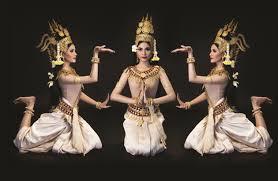

History and Geography of the Khmer Ethnic Group
Ethnic minorities often reside in remote areas or high mountains, sustaining themselves through hunting or slash-and-burn agriculture. Introducing tourism to these communities can boost their income, mitigate environmental damage, and provide a refreshing climate for visitors. Let's join hands to protect our environment and make our Earth greener, cleaner, and more beautiful.
The Khmer people are indigenous with a long history of permanent settlement, primarily in southern Vietnam, especially in the Mekong Delta. They are one of the 54 ethnic groups in Vietnam with many unique cultural features.
Historical Origins: Many studies have confirmed that the Khmer in our country are descendants of migrants from Lower Chenla, the predecessor of the modern Cambodian state. They migrated to this area in various waves and for different reasons. Along with the Vietnamese and Chinese, the Khmer are among the earliest inhabitants of the Mekong Delta. In Vietnam, the Khmer are also known by several other names such as Khmer Crôm, Lower Khmer, or Vietnamese of Cambodian origin.
Geographical Distribution: Based on ecological characteristics and the natural environment, the distribution of the Khmer in the Mekong Delta can be divided into three main regions as follows:
Inland Region: This is the oldest residential area of the Khmer in the Mekong Delta.
Coastal Region: Stretching from Tra Vinh, through Soc Trang, to Bac Lieu.
Southwestern Border Mountain Region: Located in the provinces of An Giang and Kien Giang, where there are the Thất Sơn mountains, Sap mountain, and Vọng Thê mountain.
Population and Language:
Population: According to the April 1, 2019, survey of 53 ethnic minorities, the total Khmer population is 1,319,652 people; with 650,238 males and 669,414 females; the average household size is 3.7 people per household; and 76.5% of the population lives in rural areas.
Language: The Khmer speak the Khmer language, which belongs to the Mon-Khmer group of the Austroasiatic language family
0 notes
Text
Mekong Delta Tour, Ben Tre
Ben Tre city is the provincial capital of its namesake, Ben Tre province, situated around 50 miles southwest of Ho Chi Minh City in the Mekong River Delta.
We took a tour of the local area, arranged by our home stay and in the excellent care of our local guide, Ben.
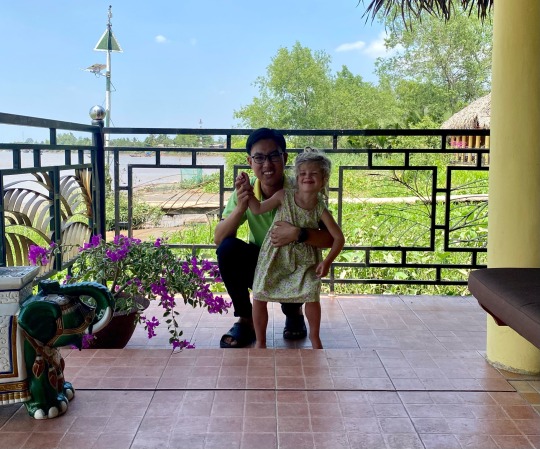
Having grown up in the local area, but also traveled to Singapore to study for his Tourism degree, Ben was able to talk to us about the local communities we visited, but also explain them in the wider context of the local and national economies, which certainly added to the experience.

Our tour included a boat trip along the Ba Lai and Ben Tre rivers, a bike ride around the backstreets of the local riverside villages, a punt up a palm-tree lined tributary, and a ride in a tuk-tuk, all punctuated by visits to several local family-run businesses.

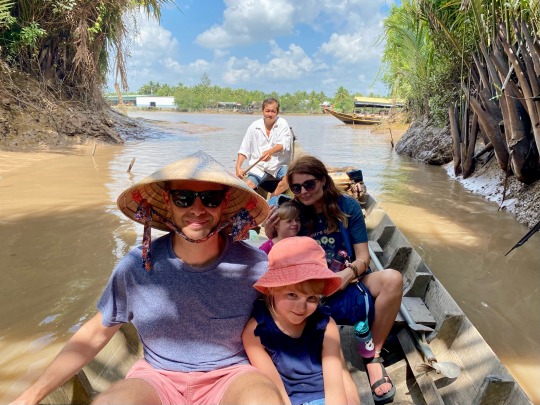
We learned that traditionally, the local economy has been centred around agriculture, with rice farming and coconut cultivation, all made possible by the irrigation provided by the vast river delta of the Mekong.
It was interesting to observe the synergies that have evolved between various local businesses. For example, we visited a small brick factory which utilised clay from exhausted rice terraces. But nothing could better express the collaborative nature of the local economy, than the extent of utility it has found for the humble coconut.
I tried to keep a mental note of all the uses we encountered for coconuts throughout the day. I’m afraid it got away from me quite early on, but the list includes construction, fertiliser, fuel, filtration, ornamental art… and all that before you even start on its nutritional value or great taste!

Other local businesses we visited on our tour included a local rice wine distillery, a coconut processing plant and an artisan rice paper manufacturer, where Del and I had the chance to try our hand at making rice paper. My effort wasn’t bad but Del’s was almost up to professional standards!

When we took the decision to take Maya out of school for a few weeks, we didn’t take it lightly, and this kind of day, filled with so many first times and hands on educational experiences, was exactly what we had in mind. So it was most rewarding to see Maya and Willow taking in everything the Mekong delta had to offer, and we came away with enough material for at least a few road-trip school days!
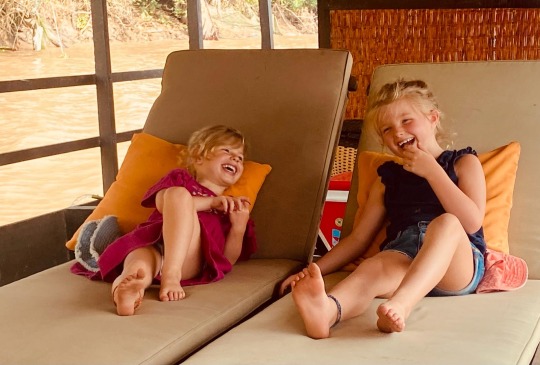
1 note
·
View note
Text
Have you looking for Mekong Cycling Tours Guide

Mekong Cycling Tours offer a distinctive and immersive way to explore the Mekong Delta region, allowing participants to experience the rich cultural tapestry, picturesque landscapes, and traditional lifestyles along the Mekong River. These cycling tours provide a unique perspective on the diverse facets of the Mekong Delta, enhancing the overall travel experience.
Commencing in Ho Chi Minh City, the gateway to the Mekong Delta, cycling tours typically traverse through lush rice paddies, charming villages, and winding pathways. One of the key highlights of these tours is the opportunity to interact with local communities, gaining insights into their daily lives and cultural practices. Participants often visit traditional markets, where the vibrant array of local produce and handicrafts adds a sensory dimension to the journey.
As cyclists pedal along the Mekong's intricate network of canals and tributaries, they encounter floating markets, a hallmark of the region's commerce. These markets provide a glimpse into the dynamic trading activities that define life in the Mekong Delta. Cycling also enables a close encounter with the region's agricultural practices, witnessing farmers cultivating rice, tropical fruits, and other crops that thrive in the fertile delta soil.
The Mekong Cycling Tours commonly include visits to historical and cultural sites such as ancient pagodas, temples, and traditional Khmer villages. Exploring these destinations by bicycle allows for a more intimate connection with the surroundings, fostering a deeper appreciation for the cultural and historical significance of the Mekong Delta.
Additionally, cycling tours often incorporate experiences like homestays, where participants stay with local families, contributing to a genuine cross-cultural exchange. This immersion into the local way of life further distinguishes Mekong Cycling Tours from conventional travel experiences.
In summary, Mekong Cycling Tours Offer an enriching and active way to explore the Mekong Delta, allowing participants to engage with the region's cultural, historical, and natural facets. This mode of travel provides a unique blend of adventure, cultural immersion, and physical activity, making it an ideal choice for those seeking a comprehensive and authentic exploration of the Mekong Delta.
Resource: https://countrysideadventuresblog.wordpress.com/2024/02/08/have-you-looking-for-mekong-cycling-tours-guide/
#Vietnam Bike Tours#Vietnam Cycling Tours#Cycling Vietnam#Vietnam Biking Tours#Mekong Cycling Tours#Mekong Bike Tours#Vietnam Kayaking#Kayaking Vietnam#Vietnam Tours#Biking Vietnam#Vietnam Package Tours#Travelling to Vietnam#Vietnam Holiday
0 notes